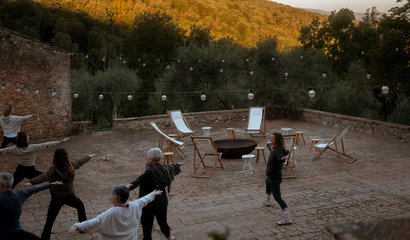Nov. 30, 2017
Put your backside into your backbends (video)
From my experience, it is really common for people to struggle with waking up their glutes and refine some of their familiar asanas to incorporate more butt and posterior leg muscles into the movements.
Ahhh, this might be my favourite tip so far. As a teacher and movement educator, I teach to the people in front of me, which means that I find in virtually all of my group classes, we spend a lot of time working on our butts. No, not sitting and doing stuff on our butts, but exploring a whole bunch of movements that build strength in the glutes (your butt muscles).
And from my experience, it is really common for people to struggle with waking up their glutes and refining some of their familiar asanas to incorporate more butt and posterior leg muscles into the movements. But when they do, holy moly... those areas wake right up and people love it.
In fact, all over the interwebs lately, have been articles about Dormant Butt Syndrome. Is it a real syndrome, who knows, but it is real that MANY people suffer from weak and underused glutes. Which can be a big contributor to lower back pain and knee pain. Some of the reasons our butts are asleep are because we have a cultural habit of sitting in chairs. A lot. And for a long time.
Sitting in chairs for hours- think cars, desks at work, couches, school desks - can weaken the glutes. Your glutes are a set of very strong muscles that are there to help support, stabilize and move you. But they are easily under used from all that sitting, wearing shoes with heels, and postural habits such as standing with your hips forward. Check out this article for more info on adjusting your posture to kick on your glutes.
In yoga, some traditions cue to relax your butt when doing certain postures such as backbends. Which is really unfortunate, because we want to use those beautiful butt muscles as much as we can, especially in backbends. Strong glutes (and posterior leg muscles such as hamstrings, etc) are there to support you. I like to think of the glutes as support for your pelvis. When you are doing a backbend such as a bridge or Urdhva Dhanurasana, what else is safely going to lift your pelvis? If we shut the glutes off, then that work gets transferred to other parts such as your quads, knees and lower back. All of these areas will work in a backbend but we don't want them to overwork when the butt is out of the picture, which leads to compensation patterns in the body.
Phew. I really could go on and on to extol the virtues of our butt muscles and why we need them, but let's look at one super simple, and super effective cue that you can bring into your backbends such as bridge, full wheel, reverse table-top and other similar movements.
Watch the video for a more detailed tutorial and read the simple cue below:
- In the start of bridge pose, lift the hips a little off the ground.
- Press your feet into the floor.
- Then drag your feet toward your body without actually moving the feet.
- You will immediately feel your backside kick on. Hurray!
Keep that work throughout your feet and backside and lift up as far as it feels comfortable in your body.
Enjoy the feeling of functional, strong butt and posterior leg muscles! And enjoy the support for your low back and knees. Feel free to share so that more people can experience stronger, happier butts :)



